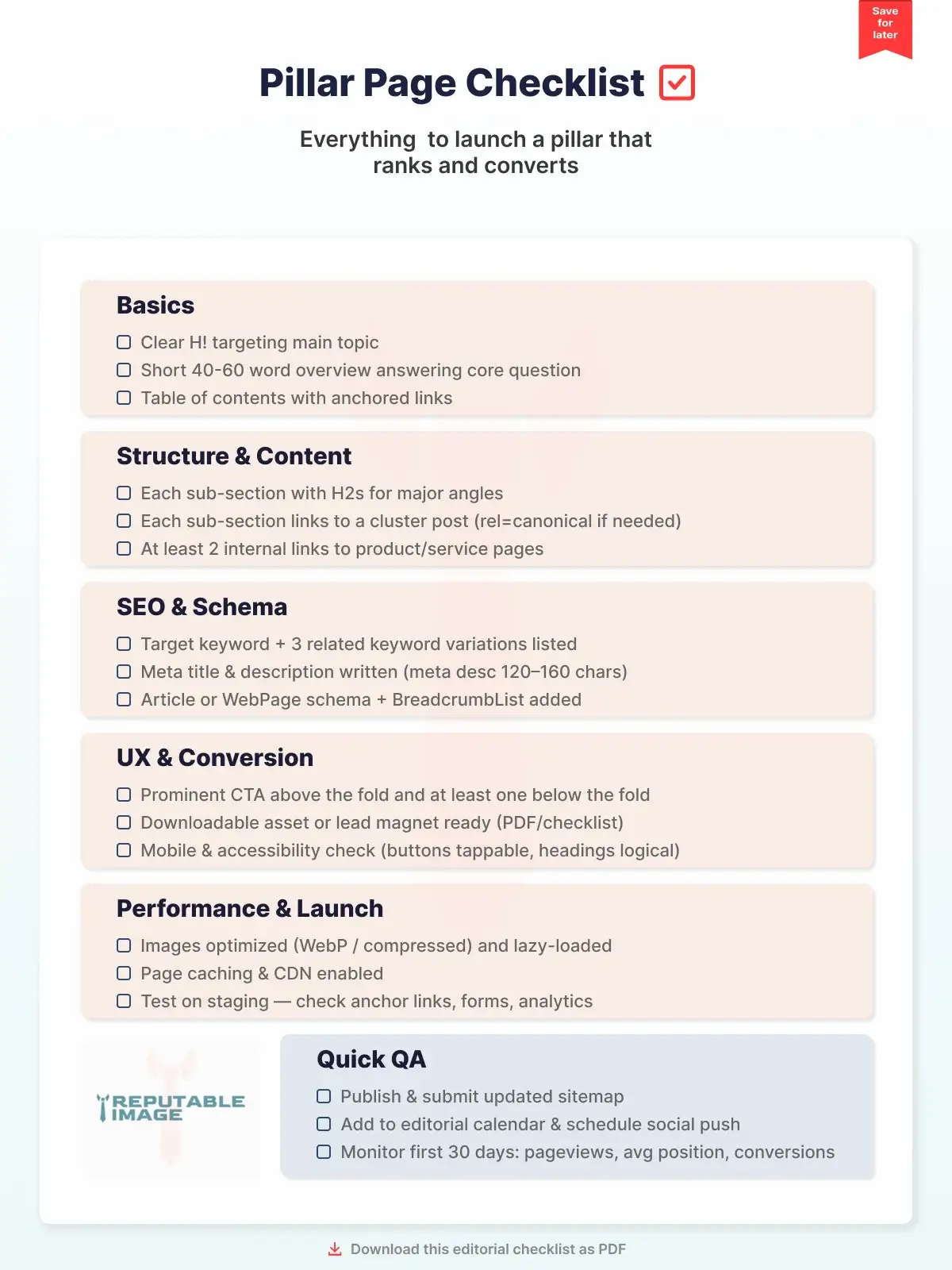
What Are Pillar Pages
and Why Have Them?
Pillar pages are long, central resources that cover a broad topic and link out to more focused “cluster” pages that explore subtopics in detail. A well-built pillar page acts as a hub for a topic cluster and improves discoverability, internal linking, and user navigation. HubSpot defines pillar pages as the backbone of topic clusters — they help both readers and search engines understand what your site covers. (HubSpot)
Why Small Businesses Should Care
For small businesses, pillar pages concentrate effort: rather than producing disconnected posts that compete with one another, you create a single hub that channels authority and clicks to supporting content. That reduces wasted content work, clarifies internal linking, and makes every new article work harder for your brand over time. The Content Marketing Institute highlights that pillar-driven clusters improve both UX and search performance. (Content Marketing Institute)
How Pillar Pages
Solve Real Pain Points
Pain: scattered content that gets little traction.
Solution: a pillar page groups related posts, so search engines see a topical hub and users can find answers quickly.
Pain: inconsistent messaging across pages.
Solution: the pillar page sets the narrative tone and links to consistent, phrased subpages.
Pain: low organic growth.
Solution: clusters increase topical authority and improve rankings for multiple related keywords.
(Conductor)
What a Pillar Page Looks Like
A pillar page typically includes a clear H1 that targets the main topic, a concise overview that answers core questions, several sub-sections (each linking to in-depth cluster posts), call-to-action elements (download, contact, demo), and helpful navigation (table of contents with anchored links). It’s long-form but scannable—mix headings, short paragraphs, lists, and visual assets to keep people moving. (HubSpot)

How to Choose Pillar Topics
Pick core topics that match your services and customer questions—topics that can support several subtopics and that align with buyer intent. Start with buyer personas and analytics: which high-value themes already get search traffic or show engagement? If a topic has multiple sub-questions, it’s a good candidate for a pillar page. Conductor’s templates are useful for mapping topics to clusters and planning content production. (Conductor)
A Simple Structure to Follow
Open with a strong overview, include an anchored table of contents, add sub-sections for each major angle (what it is, how it works, benefits, common mistakes), and link each sub-section to a supporting blog post. Add schema (Article or WebPage), a prominent CTA, and a “Resources” area with downloadable assets. Keep the pillar page updated as you publish and expand cluster content.
Content Production Workflow
Treat the pillar page as a product. Plan the pillar first, then build cluster posts that target specific long-tail keywords. Use an editorial calendar to schedule cluster content so the pillar grows organically. Convert high-performing news or short posts into permanent cluster pages when they prove traction. For building an editorial cadence that feeds pillar clusters, see Integrating Blogs & News for Content Marketing.
SEO and Internal Linking Best Practices
Use the pillar page to centralize internal links: every cluster post should link back to the pillar and to related cluster posts. Use consistent anchor text (variations of your main topic) rather than random phrases. Submit a sitemap with your pillar and cluster URL structure and consider using structured data (Article, BreadcrumbList) to help search engines. HubSpot and Content Marketing Institute both recommend the topic cluster model to reduce keyword cannibalization and improve site architecture. (HubSpot)
Measuring Success
Track organic sessions to cluster pages, average ranking for topic-related keywords, and conversions attributed to pillar-driven traffic (form fills, signups). Use topic-level reporting—group cluster pages in analytics or GA4 to see the pillar’s aggregate performance. If conversions lag, test different CTAs or move relevant cluster posts into higher-visibility areas. Use analytics to validate which cluster topics deserve expansion — see Using Analytics to Improve UX.
Common Mistakes to Avoid
Don’t make a pillar page a thin list of links—give readers immediate value on the page itself. Avoid inconsistent structure or empty headings; each sub-section should be a meaningful jump-off point. Don’t forget to update the pillar when new cluster posts add value, and don’t let cluster posts exist without linking back to the pillar.
Download the PDF here
Real-World Benefits
for Small Businesses.
Over time, pillar pages reduce the cost-per-acquisition by increasing organic traffic and improving on-site conversion paths. They make your content strategy predictable and reusable: a single pillar can support dozens of blog posts, social pieces, and lead magnets. For a small team, this means more leverage from fewer content hours.
When to start building pillars
If you have multiple posts around the same topic, if your blog traffic is plateauing, or if you want to systematize SEO growth, start planning a pillar page. Even one well-structured pillar and a few targeted cluster posts can produce measurable gains within months.
Next Steps & a Quick Checklist
- Identify 3–5 candidate topics
- Map 6–12 supporting cluster ideas
- Write a clean pillar outline with anchors
- Produce the first 2–3 cluster posts and measure
- Iterate based on analytics and feedback.
In Conclusion:
Pillar pages give small businesses a single, high-value asset that organizes related content, concentrates search authority, and makes every new post work harder over time. By turning scattered articles into a focused topic hub, you get compounding SEO gains and clearer user journeys that steadily drive more qualified traffic and leads.
Reputable Image can audit your content, map pillar topics, and design SEO-ready pillar pages that fit your brand and conversion goals. We offer copywriting, design, analytics setup, and technical implementation so your pillar pages rank and convert, part of our SEO services — Call our reps and we'll help your site rank higher on Search Engines.
Sources:
1. Sophia Bernazzani Barron at HubSpot - "What is a pillar page"
https://blog.hubspot.com/marketing/what-is-a-pillar-page
2. Zack Kadish and Stephanie Stahl at Conductor and Content Marketing Institute - "How to Boost SERP Rankings: The Role of Topic Clusters & Pillar Pages"
https://contentmarketinginstitute.com/seo-for-content/how-to-boost-serp-rankings-the-role-of-topic-clusters-pillar-pages
3. Shannon Vize at Conductor - "Topic Clusters and Pillar Pages: What They Are & Why They Matter"
https://www.conductor.com/academy/topic-clusters



